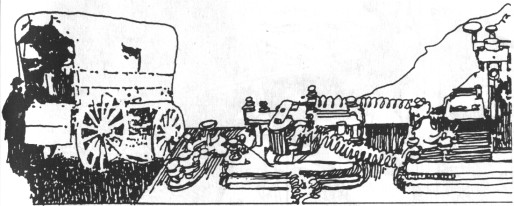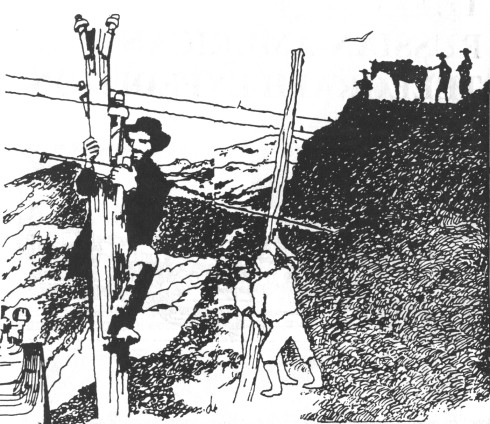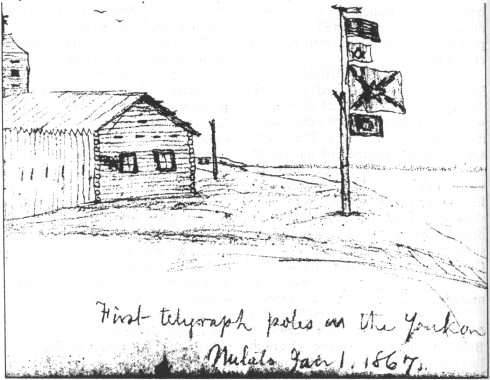The Russian-American Telegraph Expedition
by R. J. Duhse
Reprinted from "Crown Jewels of the Wire", July 1989, page 11
John Underwood of Wauchula, Florida, sent in the following article. The article
appeared in THE ELKS MAGAZINE, Vol.67, No.8, March, 1989. The magazine is
published by the Benevolent and Protective Order of Elks of the United States.
The year 1865 marked the beginning of one of the most bizarre and ambitious
adventures in American history -- the joint effort by the Western Union Company and
the Russian czar to establish an overland telegraph line between the continents
of North America and Asia. A fragile copper wire was to be strung on poles over
12,000 miles of vast unexplored areas of western Canada, the Alaskan Territory,
and the desolate steppes of Siberia, to the capitals of Europe.

In today's world
of instant global communication, it is difficult to conceive the time required a
century ago for important news to circle the planet. Although the newly invented
telegraph had spanned the United States and European countries, our contact with
Europe and Asia depended on the ships that crossed the oceans. For example,
the Europeans did not hear of President Lincoln's death until 11 days later,
when the news was delivered by a fast clipper ship from New York.
Cyrus Field
had made four attempts to remedy this gap by laying a cable under the Atlantic
Ocean. Each time the cable had snapped. To the directors of the Western Union
Company and officials of the U.S. State Department, an overland telegraph line to Europe seemed the only
solution -- not to mention a profitable investment from the monopoly thus created.

Such a plan had been previously
discussed between the U.S. consul to Russia and the Russian court. The czar
found the concept of a monopoly over his European competitors highly desirable.
Official agreements for the creation of a company to be financed by Western
Union were quickly arranged. The Russians were to build the connecting line in
their territory, from St. Petersburg to the European capitals, and share in the
new company's profits.
The new line would extend from the existing lines in San
Francisco up the Pacific Coast to New Westminster in British Columbia. From
there it would follow the Fraser River and Caribou Trail through the Yukon
Territory and Russian America (now Alaska); under the Bering Strait by cable;
then almost 2,000 miles across the desolate Siberian steppes and tundra to the
Amur River. At that point it would connect with the line from St. Petersburg.
The project was staggering in its concept. The route led across thousands of
miles of yet-unexplored territory which included extremes of heat and sub-zero cold, dense forests and treeless plains, deep snow and
boggy tundras. Construction materials had to be hauled in small ships through
ice-blocked rivers, then hauled over almost impassable routes on sleds drawn by
dog teams, or on the backs of reindeer or men. To maintain the signal over those
vast distances, automatic repeating relay stations would have to be built at
400-mile intervals, and no one knew what the effect of sub-zero cold would have
on the equipment's performance.
Necessary supplies, including food, were
delivered to base camps at certain harbors by the company's fleet of ships. Some
of these ships were caught in the winter ice and the needed supplies were
delayed. Extreme weather conditions prevented overland delivery to the advance
teams, and many were forced to live on a diet of deer, fish, and horsemeat.
The
expedition was divided into four teams. The first group was given the task of
building the new line northward from San Francisco to New Westminster. The
second group sailed to Norton Sound on the Alaskan coast, where a base was
established at Fort St. Michaels. Its assignment was to survey southward to meet
up with the first team. Teams three and four were landed at points on the
Siberian coast, one to survey the route towards the Amur River where the Russian
connection would be made; the fourth team to survey north to the Bering Strait.
The expedition was organized under former U.S. Army Colonel BulkIey of the
Signal Service, under the Army system of officers and command. Accompanying the
expedition were several young scientists and artists sponsored by the
Smithsonian Institution, whose assignment was to obtain all the data possible on
the flora, fauna, natives and their customs, the topography and weather in the
Arctic areas. This information was to prove of immense value to future
operations in that unknown part of the world.
The first team from San Francisco
had great success. By herculean efforts, the 250-man group cleared a
50-foot-wide strip through the dense forest at a rate of six miles per day,
cutting and setting poles and stringing the telegraph wires as they went. By the
winter of 1866 they had reached Quesnel, halfway across British Columbia. From
there they began a survey of the route to the Yukon River valley.
Not so
fortunate were the other teams. Their daily problems are illustrated in detailed
reports to superiors back in America, laboriously handwritten under primitive
conditions. One member was George Kennan, a 19-year-old volunteer who had been a
telegrapher in Ohio with Western Union and who had convinced his company that
his experience would be of value. Kennan kept voluminous notes during his work
in the Siberian Arctic, which he later published in a small book, Tent Life In
Siberia.
From his book emerges the picture of strong men dedicated to achieving
a seemingly impossible task. His account describes the problems of travel over
the vast and desolate Siberian steppes. In the winter the temperature could drop
to minus 60 degrees F. Clouds of snow carried by fierce polar winds blinded the
men and piled up huge drifts. At night the travelers would draw up the dogsleds to form an enclosure. Inside this slight windbreak, the snow was removed
and bearskins were laid on the frozen tundra. Twigs and moss were piled in the
center to make a large bonfire. Then the weary men wrapped themselves in layers of fur, put on fur masks, ate their hard
biscuits, drank their hot tea, and slept for a few hours. Outside the sleds, the
dogs curled into a tight ball in the deep snow. When the men awoke their beards
and eyelashes were covered with frost, their eyelids almost frozen shut.
Despite
these winter problems, travel across the steppes was only possible in the winter
when the ground was frozen and there was snow for the dogsleds. During the short
summer months a spongy moss covered the tundra. Walking was almost impossible,
the men sinking calf-deep into the wet ground at every step.
Insects were
another major problem. Captain R. J. Bush wrote from the fourth team in Siberia:
"As the summer season approaches, the deer migrate north to escape the
clouds of mosquitoes. We are compelled to wear nets day and night, and cannot
take off our skin clothing even while sleeping under our blankets. In spite of
all precautions our hands and faces were badly swollen. The mosquitoes torment
the dogs, so that in desperation they tear the hair off their backs with their
teeth."
To obtain dog food during the winter was a problem. All travel depended on healthy, well-fed animals. The men traded with the natives for deer
and dried fish, but since these items were also the staple diet of the natives,
they were often unobtainable at any cost. On occasion, horses had to be
slaughtered to feed the dogs -- and sometimes the men as well. The deer were
small, and the meat from a 70-pound animal would only be enough to feed a 10-dog
team for two days.
Since it was only possible to make appreciable advances in
the line during the winter, it was necessary for the men to cut and set poles in
deep snow and sub-zero temperatures, and often without the aid of snowshoes.
Their diet often was reduced to dried fish and deer meat, with a little tea and
flour, yet each man often managed to cut and set 30 poles per day.
Leader C.S.
Macrae wrote on June 4, 1867, from Markova, Siberia: "Sometimes the whole
party is unfit for duty on account of a severe diarrhea. I have no medicine
except laudanum and opium pills, which in cold weather makes me cautious in
using. Our provisions being reduced to a two day supply of hard bread and deer meat, I ordered work suspended and the men placed on half rations. Up to
that time Mr. Baxter and I lived on fish supplied by the natives."
Whenever
possible the work crews trapped scarce grouse and rabbits to avoid eating deer
meat, which was dry and contained little of the fat they needed. Their only
luxury was tea and sugar, which were also used in trading with the natives. As
one supervisor wrote, "We can endure almost any hardship as long as we have
our tea!"
An interesting description of the men's use of reindeer in their
work was reported by Supervisor Mahood in a March, 1866, report from Okhotsk,
Siberia.
"Our party consisted of myself and three men mounted on
deer," he wrote, "along with a pack train of 12 deer. After the first
day's experience we found it a rather agreeable means of locomotion, in many
respects preferable to horseback riding. The saddle is a small pad set on the
animal's withers, as their back is not strong, and a saddle worn there would
quickly use them up.
"There are no stirrups, and the rider has to depend
altogether on his skill in balancing to keep his seat, which is sometimes
difficult if the animal is fat, when his skin is very loose."
One incident almost led to tragedy. The fourth Siberian team was
marooned by early winter storms near the mouth of the Anadyr River, which froze
over. The team was forced to construct a rude shack of boards and driftwood
which was soon covered by driving snow, except for a tall stovepipe. There they
stayed for several months with no outside news, waiting for relief.
In the fifth
month a native hunting party reported their condition and approximate location
to the third team, now 500 miles east in Siberia. In spite of the minus-35
degree F. weather, two men set out with dog teams on a rescue mission. Reaching
the supposed site, they searched desperately for 10 days and nights without
shelter from the bitter cold. On the eleventh day they discovered an upturned
life-boat which indicated the river's mouth. Soon they spotted the stove- pipe
and dug out their greatly relieved comrades.
In spite of all their difficulties,
the Siberian teams continued to work through the hard winter of 1866, unaware of
the sad news that would greet them the following spring. They managed to hire
hundreds of natives to cut and set 20,000 poles, most of which had to be cut
from distant forests and transported on crude sledges. But meanwhile, while
these dedicated men worked so hard and successfully at their appointed task,
Cyrus Field had at last laid a cable under the Atlantic which was connected to
Europe on July 27, 1866.
The news of this successful cable had quickly reached
the crews in British Columbia over the telegraph line they had just strung.
Without official orders, they abandoned the project and headed for home, leaving
tools and supplies for the Indians and Eskimos to use as they wished. Four
hundred miles of operating line north of Quesnel also was abandoned.
But no one
could communicate with the Siberian teams, and not until the spring of 1867 did
those men hear of the cancellation of their project. A whaling ship from
Massachusetts arrived in the Sea of Okhotsk when the ice melted, bringing
newspapers that told the story of the cable. For nine months their labors had
been in vain.
Two months later the official news came from Western Union to sell
what they could of the remaining supplies. George Kennan wrote: "We sold
glass insulators as American teacups, (pole) brackets as American kindling
wood." Thousands of poles and a thousand miles of copper wire were left for
the natives' disposition.
The news was, of course, a bitter pill for the
expedition's leaders. In his final report of August 15, 1867, Captain William
Ennis wrote:
"It is a matter of sincere regret that the work has been
suspended, for we had everything so prepared that the completion of this line...was but a question of one year. We have proven that men can work in the
severest winter, and with a small amount of determination the work could have
been successfully carried through."
Back in New York the Western Union
directors were trying to cut their losses while retaining their gains. They
requested U.S. Secretary of State William Seward to urge Russia to complete the
Siberian line to some point in what is now Alaska -- then still American Siberia.
Western Union then would complete the connection to the States. Such a completed
project, they pointed out, would give the Russians better communication with
their North American colony, and, of course, benefit Western Union.
The company quickly received a vague but promising reply from Secretary
Seward, suggesting he would consider the matter. That reply was only a political
smoke screen, of course, for Seward was at that very time closing the secret deal to purchase the Russian-American territory from the czar. Two days later,
on March 3, 1867, the treaty was signed that ceded the Territory of Alaska to
the United States for a paltry $7.2 million -- a purchase that short-sighted
politicians and the press called "Seward's Folly," but which a wise
Senate ratified 10 days later.
The expedition was certainly not a complete
failure. The vast store of new knowledge gained by the Smithsonian's scientists
included valuable facts about the weather of those regions, which was to have
military implications in later years. Also invaluable was the successful
movement of men and supplies in extreme weather and the information about native
tribes and Arctic animals and plants. The surveys opened paths for the new
settlers to come.
The telegraph lines cut through the Canadian forests of the
Yukon and British Columbia pointed a way for the opening of those rich lands.
And less than 30 years later thousands of Americans followed those old lines to
search for gold and to remain as settlers of what was to become our 49th state.
But the "hot line" to Moscow would have to wait until the nuclear age
ushered in a far more urgent necessity of instant communication with those same
two distant nations, now tied so closely together by a single common fear.

| 